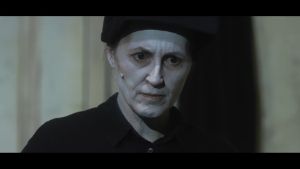The 10 most remarkable productions
Die Gewehre der Frau Carrar / Würgendes Blei
By Bertolt Brecht / A sequel by Björn SC Deigner (world premiere / commissioned work)
Residenztheater / Bayerisches Staatsschauspiel, Munich
World premiere: 14.12.2024

Die Gewehre der Frau Carrar / Würgendes Blei © Residenztheater / Bayerisches Staatsschauspiel
Luise Voigt artfully stages Bertolt Brecht’s alarmingly topical play about armament and pacifism in the aesthetics of a 1930s feature film. Dramatist Björn SC Deigner has created a sequel, searching for a language for the time-transcending horror of war and destruction.
Mrs Carrar is a pacifist and believes that she can protect her sons from the violence of the Spanish Civil War by forbidding them to join the fight against Franco and the fascists. But a fatal event leads her to taking up arms herself. Luise Voigt transposes “Die Gewehre der Frau Carrar” into the setting of a 1930s feature film and develops Brecht’s principle of alienation further with elaborate sound and visual effects – only to have it all collapse. Brecht himself had noted that his play – which premiered in 1937 and has distressing resonances today – might be presented together with a documentary film. Instead, Luise Voigt’s “Carrar”-staging is followed by a second part: At the centre of the sequel “Würgendes Blei” by Björn SC Deigner – who sees theatre as a place for negotiation, for demands and for instigation – are the specific consequences for those who go to war. The combination of both parts results in a focused, score-like show that asks whether neutrality is even possible in the face of a violent attack.
Statement of the Jury
Do weapons bring about peace or just more war? Bertolt Brecht’s “Die Gewehre der Frau Carrar” (Señora Carrar’s Rifles), first staged by German refugees in Paris in 1937, is the play of the hour. Mrs Carrar wants to save her sons’ lives and therefore initially takes a rigorous pacifist stance. This rarely performed play about the Spanish civil war hits home like a hammer today. Luise Voigt stages it in the aesthetics of a 1930s movie: The set shimmers, the sound rustles and crackles and the landscape outside the window appears as expressionistic as a paper cut-out. Afterwards, Björn SC Deigner’s “Würgendes Blei” (Choking Lead) begins on the ruins of the past – as a piece for Mrs Carrar, a linden leaf, a machine gun and a chorus, as a religious service for the return of the ever identical horrors of war. How to escape this vicious circle?
ProgrammeBooklet (pdf, 0.17 MB)
Artistic Team
Luise Voigt – Director
Fabian Wendling – Stage Design
Maria Strauch – Costume Design
Friederike Bernhardt – Music
Tony De Maeyer – Choreography
Stefan Bischoff – Video
Barbara Westernach – Lighting Design
Ewald Palmetshofer – Dramaturgy
Cast
Die Gewehre der Frau Carrar
Barbara Horvath – Teresa Carrar, a fisherwoman
Pujan Sadri – José, her younger son
Oliver Stokowski – Pedro Jaquéras, a worker, brother of Teresa Carrar
Volodymyr Melnykov – The wounded man
Naffie Janha – Manuela / a linden leaf
Florian Jahr – The priest / a machine gun
Evelyne Gugolz – Old Mrs Perez
Würgendes Blei
Barbara Horvath – Teresa Carrar
Pujan Sadri – José, her remaining son
Oliver Stokowski – Pedro Jaquéras, a worker, brother of Teresa Carrar
Florian Jahr – A machine gun
Naffie Janha – A linden leaf
Ensemble – A chorus who can play anyone except Teresa Carrar
Performing rights: Suhrkamp Verlag, Berlin / S. Fischer Verlag, Frankfurt am Main




